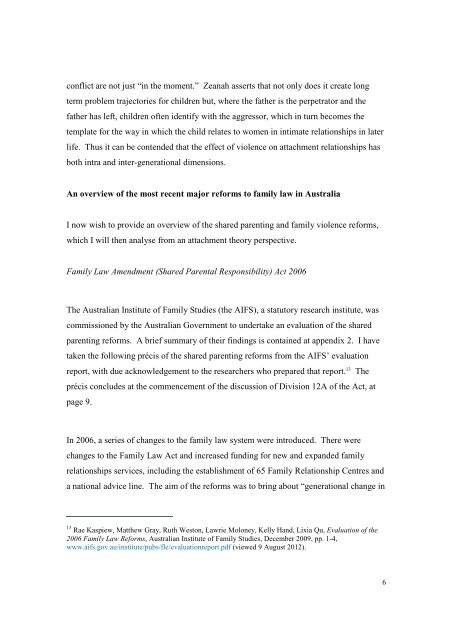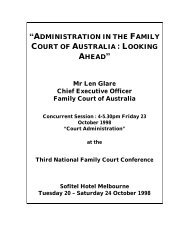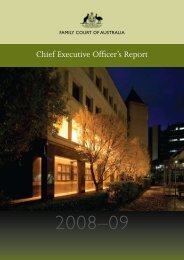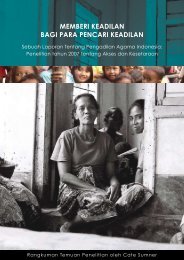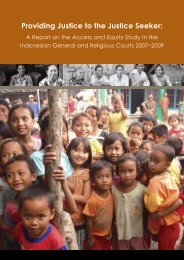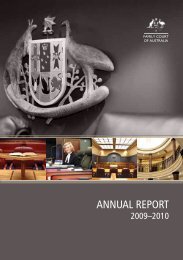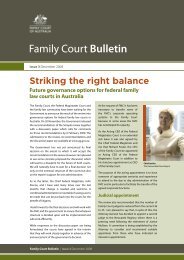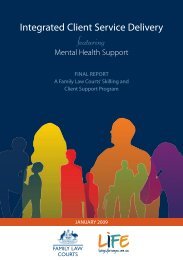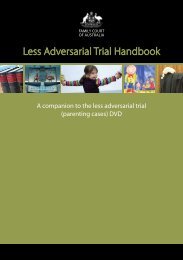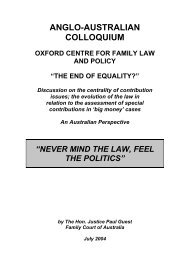Attachment Theory and the Family Violence Reforms
Attachment Theory and the Family Violence Reforms
Attachment Theory and the Family Violence Reforms
Create successful ePaper yourself
Turn your PDF publications into a flip-book with our unique Google optimized e-Paper software.
conflict are not just “in <strong>the</strong> moment.” Zeanah asserts that not only does it create longterm problem trajectories for children but, where <strong>the</strong> fa<strong>the</strong>r is <strong>the</strong> perpetrator <strong>and</strong> <strong>the</strong>fa<strong>the</strong>r has left, children often identify with <strong>the</strong> aggressor, which in turn becomes <strong>the</strong>template for <strong>the</strong> way in which <strong>the</strong> child relates to women in intimate relationships in laterlife. Thus it can be contended that <strong>the</strong> effect of violence on attachment relationships hasboth intra <strong>and</strong> inter-generational dimensions.An overview of <strong>the</strong> most recent major reforms to family law in AustraliaI now wish to provide an overview of <strong>the</strong> shared parenting <strong>and</strong> family violence reforms,which I will <strong>the</strong>n analyse from an attachment <strong>the</strong>ory perspective.<strong>Family</strong> Law Amendment (Shared Parental Responsibility) Act 2006The Australian Institute of <strong>Family</strong> Studies (<strong>the</strong> AIFS), a statutory research institute, wascommissioned by <strong>the</strong> Australian Government to undertake an evaluation of <strong>the</strong> sharedparenting reforms. A brief summary of <strong>the</strong>ir findings is contained at appendix 2. I havetaken <strong>the</strong> following précis of <strong>the</strong> shared parenting reforms from <strong>the</strong> AIFS’ evaluationreport, with due acknowledgement to <strong>the</strong> researchers who prepared that report. 13 Theprécis concludes at <strong>the</strong> commencement of <strong>the</strong> discussion of Division 12A of <strong>the</strong> Act, atpage 9.In 2006, a series of changes to <strong>the</strong> family law system were introduced. There werechanges to <strong>the</strong> <strong>Family</strong> Law Act <strong>and</strong> increased funding for new <strong>and</strong> exp<strong>and</strong>ed familyrelationships services, including <strong>the</strong> establishment of 65 <strong>Family</strong> Relationship Centres <strong>and</strong>a national advice line. The aim of <strong>the</strong> reforms was to bring about “generational change in13 Rae Kaspiew, Mat<strong>the</strong>w Gray, Ruth Weston, Lawrie Moloney, Kelly H<strong>and</strong>, Lixia Qu, Evaluation of <strong>the</strong>2006 <strong>Family</strong> Law <strong>Reforms</strong>, Australian Institute of <strong>Family</strong> Studies, December 2009, pp. 1-4,www.aifs.gov.au/institute/pubs/fle/evaluationreport.pdf (viewed 9 August 2012).6


